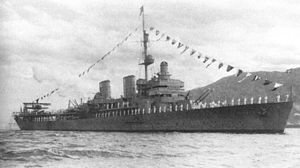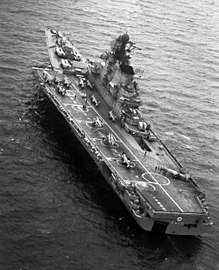Aircraft cruiser
You can help expand this article with text translated from the corresponding article in Russian. (October 2011) Click [show] for important translation instructions.
|
This article needs additional citations for verification. (December 2012) |

The aircraft cruiser (also known as aviation cruiser or cruiser-carrier) was originally a 1930s experimental concept of creating an all-around warship, trying to combine all the good features of the aircraft carrier and the heavy cruiser. The early aircraft cruisers were usually armed with relatively heavy artillery, mines and a number of aircraft fitted with floats (making the ship a kind of seaplane tender).
The early aircraft cruiser turned out to be an unsuccessful design. The rapid development of naval aircraft in the 1930s quickly rendered the vessels obsolete and they were rebuilt e.g. as anti-aircraft cruisers.
A more modern derivative of the aircraft cruiser is the helicopter cruiser. The -class aircraft carriers of the Royal Navy could also be considered; they were originally classed as cruisers due to their original role as command and control platforms as well as anti-submarine warfare (ASW) vessels, taking on those roles from the RN's -class cruiser conversions).
In the Russian Navy, "Aviation Cruiser" is a designation for the [[Kiev-class aircraft carrier |]] and -class ships. They are a cross between cruiser and aircraft carrier and are divided in two classes, the aviation cruisers and the heavy aviation cruisers.
Early types
One United States design for a flight deck cruiser from 1930,[1] was described as "a Template:Sclass- light cruiser forwards [and] one half of a Template:Sclass- aft".[2] Although not built, similar ships were created during and after World War II as reconstructions and later from the keel up. During World War II, in part to offset the loss of carriers at the Battle of Midway, Japan rebuilt its Template:Sclass-s as hybrid carriers, with guns forward and amidships and a flight deck and hangar aft.
Helicopter cruisers
Post-war the United Kingdom reconstructed the Tiger-class cruisers, HMS Blake and HMS Tiger into helicopter cruisers, retaining their guns forward but having their aft guns removed for the installation of a hangar and helicopter platform for the operation of four Sea King helicopters.
The Italian Template:Sclass-s and Vittorio Veneto, French Jeanne d'Arc and Soviet Template:Sclass- helicopter cruisers were built from the keel up as guided missile cruisers forward and helicopter carriers aft.
Soviet and Russian aviation cruisers
The first class of Soviet aviation cruiser is represented by the Kiev class and the second class is represented by the Kuznetsov class. The Kiev class can carry VTOL aircraft and helicopters, the Kuznetsov class can carry helicopters and conventional aircraft like the Sukhoi Su-33 or the Mikoyan MiG-29K. Aviation cruisers are not fitted with catapults but the heavy aviation cruisers have a ramp ("Ski Jump") to assist take off.
Aviation cruisers have a variety of heavy weapons to engage the full gamut of surface, submarines and aircraft adversaries. In addition, these ships have close-in weapon systems, both gun and missile, for self-defense against missiles or rockets.
Aircraft cruisers

Early types
- Mogami
- Template:Sclass-; fully functional heavy cruisers, but incorporated a heavy seaplane element for scouting purposes
- HSwMS Gotland
Later types
References
- Notes
- Bibliography
- Bonner, Kermit (1997). Final Voyages. Paducah, KY: Turner Publishing. ISBN 978-1-56311-289-8. Retrieved 2010-12-08.
- Friedman, Norman (1983). U.S. Aircraft Carriers: An Illustrated Design History. Annapolis, MD: United States Naval Institute Press. ISBN 978-0-87021-739-5. Retrieved 2010-12-08.
